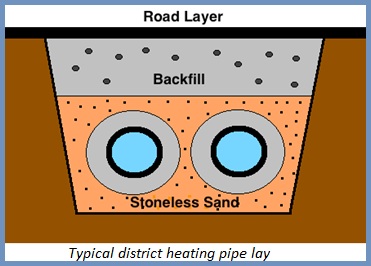

It is also important to consider the ground that they pipes will be buried in. The depth of the pipes is reliant on the surface type. For example, heavy traffic would require the pipes to be buried further underground than it would under farm land.
In the diagram shown it can be seen how district heating pipes are usually buried. First the pipes are surrounded by a layer of stonesand, before a layer of backfill, and these layers are separated by a layer of warning tape.
The minimum depth required for a pipe is 400mm, however existing service pipes have been identified such as water and gas pipes. Therefore the exact depth and route would need to be decided after detailed surveys are performed on the ground to identify any existing pipes or electrical cables.
The piping network of a district heating scheme will also include:
- pre-formed 45°/90° bends
- isolating valves and air vents
- expansion devices anchors
- Leak detection systems
PIPE MATERIAL SELECTION
A variety of piping materials are available for any district heating network. However, some are more appropriate than others depending on various factors. This section will investigate the benefits of pre-insulated steel pipes over other alternatives.
Many district heating networks are designed to use pre-insulated steel pipes. Usually pre-insulated steel pipes consist of a steel carrier pipe with polyurethane foam insulation. The internal diameter of pre-insulated steel pipes range from 25 mm - 1000 mm. Pre-insulated steel pipes are usually preferred to plastic pipes for several important reasons. Steel pipes have a much longer lifetime than plastic pipes at a high water temperature.
Depending on who finances the district heating scheme, the payback period for a district heating scheme will be considerable. Consequently, the lifetime of the piping chosen is important to ensure a long operating lifetime and a acceptable income from the scheme.
References:
- Uponor Housing Solutions Ltd. (2007). Pre-insulated piping systems. Installation and technical guide.
- Howell, M. (2008). Best Practice for District Heating. Newquay: Vital Energi Utilities Limited.